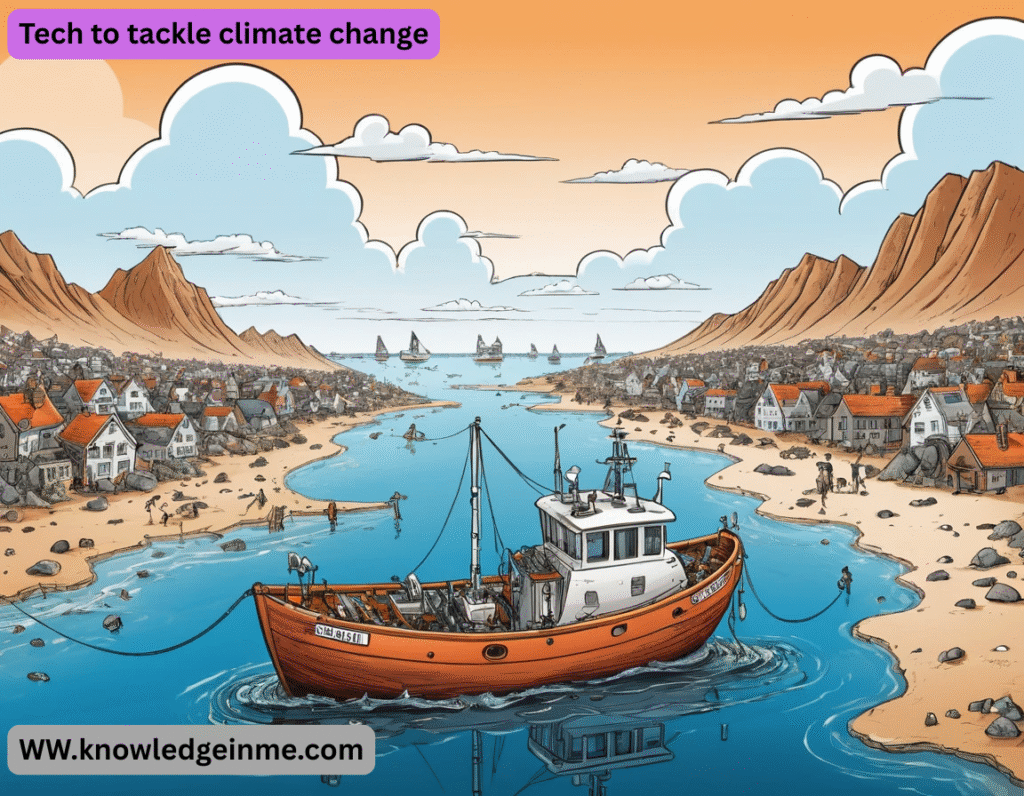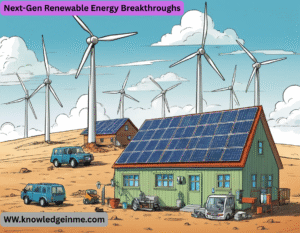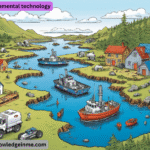Tech to tackle climate change Tackling climate change requires a combination of cutting-edge technologies, policy support, and behavioral changes. Here are some key tech-driven solutions that can help mitigate and adapt to climate change:
Renewable Energy Technologies
- Solar Power: Advanced photovoltaics (PV), perovskite solar cells, and solar farms.
- Wind Energy: Offshore wind turbines and floating wind farms.
- Hydropower & Tidal Energy: Small-scale hydro and wave energy converters.
- Geothermal Energy: Enhanced geothermal systems (EGS) for clean baseload power.
Energy Storage & Grid Modernization
- Battery Tech: Solid-state batteries, flow batteries, and sodium-ion batteries.
- Grid-Scale Storage: Pumped hydro, compressed air, and thermal storage.
- Smart Grids: AI-driven demand response and decentralized energy systems.
Carbon Capture & Removal
- Direct Air Capture (DAC): Machines that pull CO₂ from the air (e.g., Clime works, Carbon Engineering).
- Enhanced Mineralization: Accelerating natural CO₂ absorption in rocks.
Green Hydrogen & Alternative Fuels
- Green Hydrogen: Produced via electrolysis using renewable energy (for industry & transport).
- Biofuels: Advanced algae-based and cellulosic biofuels.
Sustainable Agriculture & Food Tech
- Precision Farming: AI, drones, and IoT for efficient resource use.
- Vertical Farming: Indoor agriculture with reduced water and land use.
- Lab-Grown Meat & Plant-Based Alternatives: Reducing methane emissions from livestock.
Transportation Innovations
- Electric Vehicles (EVs): Improved batteries, charging infrastructure, and EV trucks.
- Hydrogen-Powered Transport: Fuel cell vehicles for heavy transport.
- Sustainable Aviation Fuels (SAF): Low-carbon jet fuels from waste and synthetic sources.
Climate Adaptation & Resilience Tech
- Early Warning Systems: AI and satellite monitoring for extreme weather.
- Flood & Drought Tech: Smart water management and desalination.
- Cool Roofs & Green Buildings: Reflective materials and energy-efficient designs.
Circular Economy & Waste Tech
- Advanced Recycling: Chemical recycling for plastics.
- Carbon-Negative Materials: Hempcrete, mycelium-based packaging.
- Waste-to-Energy: Converting waste into biogas or electricity.
AI & Big Data for Climate Action
- Climate Modeling: Supercomputers predicting climate impacts.
- Carbon Tracking: Blockchain for transparent emissions monitoring.
- Optimization Algorithms: Reducing energy use in industries and cities.
Geoengineering Controversial but Potential
- Solar Radiation Management (SRM): Reflecting sunlight (e.g., stratospheric aerosols).
- Ocean Fertilization: Boosting phytoplankton to absorb CO₂.
Next-Gen Renewable Energy Breakthroughs
Advanced Solar Technologies
- Perovskite Solar Cells: Could surpass silicon in efficiency (over 30%) and be cheaper to produce.
- Solar Skins & Transparent PV: Integrate solar into windows (e.g., Ubiquitous Energy) and building facades.
Offshore Wind Innovations
- Floating Wind Turbines: Deploy in deep waters (e.g., HYWIND Scotland), unlocking vast wind potential.
- Kite Power: High-altitude wind energy using tethered drones (e.g., Makani).
Nuclear Fusion
- ITER (France) and private ventures (Helion, Commonwealth Fusion) aim for net-energy fusion by the 2030s—a potential game-changer for zero-carbon baseload power.
Carbon Dioxide Removal CDR Tech
Direct Air Capture (DAC)
- Clime works (Iceland): Orca plant captures 4,000 tons of CO₂/year, stores it underground.
- Challenge: High energy needs (~1,000 kWh/ton CO₂); requires cheap renewables.
Biochar
- Pyrolyzing organic waste to create stable carbon-rich charcoal (stores CO₂ for centuries).
- Scalable for farming (improves soil health) and industrial use.
Ocean-Based CDR
- Electrochemical CO₂ Removal: Running seawater through reactors to extract CO₂ (e.g., CAPTURA).
Hydrogen Economy: Beyond the Hype
Green Hydrogen (Electrolysis + Renewables)
- Uses: Steel production (replacing coking coal), shipping fuel, long-term energy storage.
- Challenges: High cost (~$5/kg today, needs to hit <$1/kg for viability).
Turquoise Hydrogen
- Methane pyrolysis splits natural gas into hydrogen + solid carbon (no CO₂ emissions if powered by renewables).
Hydrogen-Powered Aviation
- Airbus’s ZEROE program aims for hydrogen jets by 2035; short-haul flights first.
Industrial Decarbonization
Green Steel
- HYBRIT (Sweden): Uses green hydrogen instead of coal (cuts 90% of emissions).
- Boston Metal: Electrolysis of iron ore (no carbon input).
Low-Carbon Cement
- Carbon Cure: Injects CO₂ into concrete, locking it away while strengthening material.
- Brimstone: Makes cement from carbon-negative processes.
Food & Land Use Tech
Alternative Proteins
- Precision Fermentation: Brewing proteins (e.g., Perfect Day’s animal-free dairy).
- Cultivated Meat: Lab-grown meat (e.g., UPSIDE Foods) avoids livestock methane.
Climate-Smart Agriculture
- Nitrogen-Fixing Microbes: Reduce synthetic fertilizer use (e.g., Pivot Bio).
- AI-Driven Crop Optimization: Predict yields and reduce water/fertilizer waste.
Transportation Overhaul
Electric Vehicles (EVs) 2.0
- Solid-State Batteries: Higher energy density, faster charging (Toyota aims for 2027 rollout).
- Battery Recycling: Redwood Materials and Li-Cycle recover >95% of battery metals.
Fuels for Hard-to-Decarbonize Sectors
- Porsche’s HARU Oni plant (Chile) makes e-gasoline from wind power + CO₂.
Autonomous Electric Fleets
- Self-driving EVs (e.g., WAYMO) could cut urban emissions by optimizing routes and reducing congestion.
Climate Adaptation Tech
Resilient Infrastructure
- Self-Healing Concrete: Reduces rebuild emissions (uses bacteria to repair cracks).
- Floating Cities: Dutch-designed amphibious homes for sea-level rise.
Water Tech
- Atmospheric Water Harvesters: Pull drinking water from air (e.g., SOURCE Hydro panels).
- Desalination + Solar: Cheap, renewable-powered freshwater (e.g., Sahara Forest Project).
Geoengineering High Risk, Last Resort?
Solar Radiation Management (SRM)
- Stratospheric Aerosols: Mimicking volcanoes to reflect sunlight (risks: uneven cooling, ozone impact).
- Marine Cloud Brightening: Spraying seawater to enhance cloud reflectivity (e.g., Project Silver Lining).
Nuclear Fusion: The Holy Grail of Energy
Breakthroughs:
- Helion Energy (USA): Uses pulsed magnetic fusion (not tokamaks) and claims it will hit net electricity by 2028. Their reactor heats plasma to 100 million °C and directly extracts electricity (no steam turbines).
- SPARC (MIT/CFS): High-field superconducting magnets could enable compact fusion reactors by 2030.
Why It Matters:
- Unlimited, on-demand, zero-carbon energy—no long-lived radioactive waste.
- If scaled, fusion could replace fossil fuels for grid power, hydrogen production, and even carbon capture.
Obstacles:
- Engineering plasma stability and materials that survive neutron bombardment.
Artificial Photosynthesis: Plants, But Better
How It Works:
- Mimics nature: Uses sunlight + catalysts to split water (H₂O) into hydrogen (H₂) and oxygen (O₂), then combines H₂ with CO₂ to make fuels (e.g., methanol).
- Twist Bioscience & Harvard: Engineered bacteria that turn CO₂ into sugar, fuels, or plastics.
Potential Impact:
- Carbon-negative fuels: Suck CO₂ from air while producing jet fuel or gasoline substitutes.
- Decentralized energy: Could work in deserts, using sunlight and air.
Challenges:
- Efficiency is still low (~10% vs. 20% for solar panels).
- Scaling catalysts (often rare metals like iridium) is expensive.
Quantum Computing for Climate
Applications:
- Battery Design: Simulating molecular interactions to discover better lithium alternatives.
- Fusion Optimization: Modeling plasma behavior in real time.
- Carbon Capture: Designing ultra-efficient MOFs (metal-organic frameworks) to absorb CO₂.
Who’s Leading:
- IBM, Google, and startups like Psi Quantum are partnering with energy firms.
- DIRAQ: Using silicon-based qubits (scalable with existing chip factories).
Reality Check:
- Still in “noisy intermediate-scale quantum” (NISQ) era—useful for niche optimizations, not magic bullets.
CRISPR & Synthetic Biology for Carbon Sequestration
Radical Examples:
- CO₂-Eating Bacteria: Lanza Tech engineers microbes to convert industrial emissions into ethanol.
- Supercharged Plants: Salk Institute’s “Harnessing Plants Initiative” modifies crops to grow deeper roots (storing more carbon in soil).
- Lab-Grown Coral: Reviving reefs with heat-resistant, CO₂-absorbing strains.
Ethical Risks:
- Unintended ecosystem impacts (e.g., GMO microbes escaping labs).
- Who controls “climate-altering” organisms?
Space-Based Climate Tech
Wild (But Serious) Ideas:
- Orbital Solar Farms: Japan’s JAXA plans to beam solar energy from space via microwaves by 2030.
- Lunar Helium-3 Mining: For future fusion reactors (He-3 is cleaner than deuterium-tritium).
- Asteroid Mining: Nickel and cobalt for EV batteries without Earth’s dirty mining.
Problems:
- Launch costs must drop further (Starship helps).
- Space debris and geopolitical tensions.
Self-Healing Materials & Zero-Waste Manufacturing
Innovations:
- Living Concrete: University of Colorado’s bacteria-infused bricks regenerate when cracked.
- Infinite Recycling: CARBIOS’ enzyme-based process breaks down plastics to virgin-quality materials.
- 3D-Printed Cities: ICON’s robotic construction cuts cement use by 50%.
Climate Hacking the Oceans
Controversial but Potent:
- Iron Fertilization: Dumping iron to spur phytoplankton blooms (absorbs CO₂).
- Alkalinity Enhancement: Grinding olivine rock to spread on beaches, speeding up CO₂ capture.
Risks:
- Could disrupt marine ecosystems (e.g., toxic algal blooms).
- Hard to monitor and regulate in international waters.






